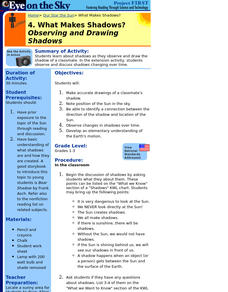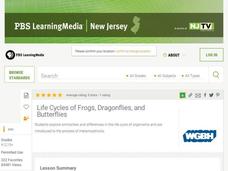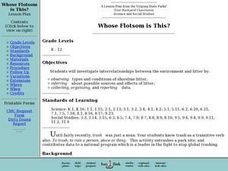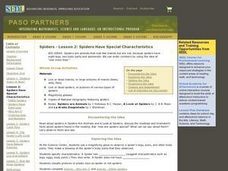Curated OER
And the Verdict Is...
Students identify the unique pattern DNA forms in each individual, and how that pattern can be used to identify criminals. They have the opportunity to simulate the process of matching DNA samples to those taken at a crime scene.
Curated OER
Pumpkin Investigation
Students examine pumpkins and make a book depicting and describing the inside and outside of a pumpkin.
Curated OER
What Makes Shadows? Observing and Drawing Shadows
Students make accurate drawings of a classmate's shadow. They note position of the sun in the sky. They identify a connection between the direction of the shadow and the location of the sun. They observe changes in shadows over time.
Curated OER
Geology: How to Make a Rock
Second graders examine the various kinds of rocks and make a flipbook about them. They draw pictures of the rocks and write several sentences about how each type of rock is made. They discover the differences in the rocks by making...
Curated OER
Incubation and Embryology
Students examine chickens, eggs and hatching eggs through this series of lessons.
Curated OER
Creative Calendars
Students review information they have learned on an animal or habitat. After conducting a specific animal or habitat unit, they create a calendar as a culminating project.
Curated OER
Sound Vibrations - Senses
Students experience vibrations using several of their senses, and design a test that uses their sense of hearing to judge the effectiveness of different solids to transmit sound vibrations.
Curated OER
Substances And Chemical Reactions
Students observe chemical reactions that produce obvious effects. They begin by exploring a different substance every day for one week. They compare the substances and examine how substances can be solids, liquids, or gases.
Curated OER
PLANT LIFE CYCLES
Student learns about the life cycle of plants by watching a time-lapse video. This activity provides students with further evidence that all living things grow and change as they progress through their life cycle. Student conducts a...
Curated OER
Sound Vibrations
Students play their own straw kazoos and understand that vibrations are responsible for the sounds we hear. Additionally, they learn that sound vibrations can travel through different mediums. Students experience vibrations through...
Curated OER
Life Cycles of Frogs, Dragonflies, And Butterflies
Students explain the similarities and differences in the life cycles of organisms. The instructional activity begins with a reading of Eric Carle's The Very Hungry Caterpillar.
Curated OER
Arthropods at Home: Spider, Isopod, or any Arthropod
Second graders observe, discuss, and record the requirements of a healthy environment for both arthropods and people by designing and maintaining an artificial habitat for an arthropod, and considering the requirements for a healthy body...
Curated OER
CUPCAKE CORE SAMPLING
Young scholars explore what is beneath the surface of the earth is one of the jobs of a geologist. Rather than digging up vast tracts of land to expose an oil field, or to find coalbearing strata, core samples can be taken.
Curated OER
Simple Machines: Levers
Young scholars discover the fundamentals and daily applications of simple machines. They investigate basic engineering theory through their hands-on demonstrations of levers.
Curated OER
Whose Flotsam is This?
Students investigate interrelationships between the environment and litter. They observe the types of litter found on a shoreline and collect information about it to infer from where it came.
Curated OER
Spiders Have Special Characteristics
Students state reasons why spiders are grouped in specific categories, including what distinguishes a spider from an insect. They report on their observations of the spiders. They illustrate their report with drawings in their journals.
Curated OER
The Spider's Life Cycle
Students see that spiders have a life cycle, and reproduce by laying many eggs. We can count by ones, twos, fives, or as many as we want. They make two lists of animals on a chart.
Curated OER
Sound Portraits
Students observe a variety of sounds which can be heard within their schoolyard habitat by sitting quietly by themselves for five minutes, listening, and then recording the sounds around them by drawing them.
Curated OER
Lesson Plan Seven: Sensorama
Students identify five senses, and use their senses of touch, sight, hearing, smell, and taste to distinguish different objects, sounds, smells and tastes, and write their answers in the booklet.
Curated OER
The Weight of Water
Students examine how salt water is more dense than fresh water through experimentation with eggs.
Curated OER
Fahrenheit Follies
Second graders analyze the effects of sunlight on a glass of water by using the thermometer to measure its temperature. They predict and measure the difference between water outside in the sun and shade and inside. They role-play a game...
Curated OER
A Couch or a Potato
Students classify objects and organisms seen on the Wakulla Springs icam website as living or nonliving.
Other popular searches
- Earth Science
- Physical Science
- Life Science
- Science Project
- Science Space
- Environment Science
- History of Science
- Environmental Science
- Pe Science
- Family and Consumer Science
- Consumer Science
- Social Science
























